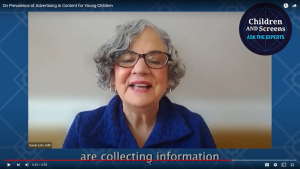
Persuasive design, stealth advertising, advergames and paid influencers…parents and caregivers today grapple with increasingly complex and sophisticated strategies of marketing and advertising to children. How are these techniques impacting youth and what is being done about it?
Children and Screens held the #AskTheExperts webinar “Captive Market: Protecting Children in the New World of Online Advertising” on Wednesday, March 1, 2023 at 12pm ET via Zoom. A panel of researchers, child development experts, and industry watchdogs explored children’s experiences with hidden online advertising and its influences on their attitudes and behaviors, how youth data is collected and used for targeted marketing, and what parents and policymakers can or should do to safeguard children online.
Speakers
-
Bonnie Patten, Esq.
Executive DirectorModerator
-
Susan Linn, EdD
Lecturer in Psychiatry; Research Associate
-
Michelle Rosenthal, Esq.
Senior Staff Attorney
-
Omni Cassidy, PhD
Assistant Professor of Population Health
Resources Mentioned During the Webinar
- Truth in Advertising (Organization Website)
- Federal Trade Commission (Organization Website)
- Children's Online Privacy Protection Rule ("COPPA") (Policy)
- Federal Trade Commission Hotline (Organization Website)
- How to File a Complaint with the Federal Trade Commission (Video)
- Fairplay: Childhood Beyond Brands (Organization Website)
- Screen Time Action Network (Organization Website)
- Center for Digital Democracy (Organization Website)
00:00 Intro, Bonnie Patten, Esq.
Kris Perry, MSW, Executive Director of Children and Screens: Institute of Digital Media and Child Development, introduces the webinar and panel moderator, Bonnie Patten, Executive Director and co-Founder of truthinadvertising.org (TINA.org). Patten sets the stage for children’s exposure to online advertising by first reviewing statistics of youth media use. She also shows examples of recent ad campaigns on various platforms, displaying some of the tactics used to target youth in deceptive ways.
11:28 Susan Linn, EdD
Susan Linn, EdD, author, psychologist, and founding Director of Campaign for a Commercial-Free Childhood (now Fairplay), describes how exposure to advertisements impacts the lives of children, reviewing impacts across learning, physical and mental health, family and peer interactions, and creative play. Dr. Linn delves into research findings related to materialism across development, including impacts to well-being and life values. To conclude, she reviews decades of research into the impacts of television advertising and compares this to the advanced techniques of new online marketing strategies.
24:08 Omni Cassidy, PhD
Omni Cassidy, PhD, Assistant Professor in the Department of Population Health at NYU Grossman School of Medicine/Langone Health and Director of the Food, Culture, & Tech Lab, describes how food and beverage companies collect extensive data from social media users and communities to target youth populations. Dr. Cassidy explains how advertisers disproportionately target communities of color, typically marketing unhealthy foods that can influence consumption practices and long-term health. She then provides specific steps parents can take to “reclaim” their children’s data and attention and manage their family’s privacy online.
38:14 Michelle Rosenthal, Esq.
Michelle Rosenthal, Esq., Senior Attorney in the Division of Advertising Practices in the FTC’s Bureau of Consumer Protection, shares existing policies related to youth advertising online, what limitations the FTC faces in this area, and current examples of how the FTC is fighting for protection of children’s data online. Rosenthal discusses the FTC’s recent legal settlement with Epic Games, who was found guilty of tricking users, particularly minors, into adding unwanted charges in their accounts.
54:03 Panel Q&A
Patten brings the panelists together for a group discussion addressing questions submitted from the audience. Panelists shared advice on how parents can develop critical thinking and online literacy skills for themselves and for their children, and discussed the need for a public health campaign in this area. Other topics reviewed include the potential impacts of artificial intelligence on increasingly advanced campaigns, the current rights of advertisers under the US constitution, how COPPA protects children’s data, and what resources are available to parents to take action.
[Kris Perry]: Welcome, everyone. I am Kris Perry, Executive director of Children and Screens: Institute of Digital Media and Child Development. And I am pleased to welcome you to today’s Ask the Experts webinar: Captive Market: Protecting Children in the New World of Online Advertising. If you’ve ever interacted online, you’re likely aware of the profusion of advertisements that you can encounter and in some cases that feel like they follow you from social media to streaming TV and back again, some may find this experience helpful and others frustrating, but we might all think twice about the ethics of this new landscape of marketing. Especially when the same tactics are being used with children every day, from adware gamers to paid influencers, product placement and micro-transactions, children are bombarded with information about toys, games, food, shows and other products. What effect do these ads have on children’s preferences and behaviors, and how do they impact family interactions and decisions? What can we do to better protect child privacy online and limit deceptive marketing practices on children’s platforms? For this webinar, we have brought together a panel of researchers, child development experts, and industry watchdogs to discuss children’s experiences with different forms of online advertising and what caregivers can do to limit any potential harmful impacts, protect their children’s data, and reduce their exposure to stealth advertising online.The panel will also discuss what can be done at a policy level to limit these practices and better safeguard children online. The panel has reviewed your pre submitted questions and you may use the Q&A box at the bottom of your Zoom screen to submit any additional questions you may have throughout the webinar. The panel will answer as many as they are able through the presentation and a group discussion across the next 90 minutes. Without further ado, I am honored to introduce you to today’s moderator, Bonnie Patten. Bonnie is the Executive Director and co-founder of Truth in Advertising.org, a nonprofit consumer advocacy organization focused on protecting consumers from false advertising and deceptive marketing. TiNA.org’s work has uncovered deceptive practices and false advertising that often target vulnerable consumers. Bonnie is the recipient of the 2019 Florence Kelley Consumer Leadership Award and from the NCL for her work fighting false and deceptive advertising. Welcome, Bonnie.
[Bonnie Patten]: Thank you so much, Kris, for that warm introduction. I’m going to start by sharing my screen here. So good afternoon. As Kris mentioned, my name is Bonnie Patten and I am the Executive Director of TiNA.org, which is a nonpartisan, nonprofit consumer advocacy organization that works to combat deceptive advertising and consumer fraud, promote understanding of the harms commercial dishonesty inflicts, and work with consumers, synergy organizations, and government agencies to advance countermeasures that effectively prevent and stop deception in our economy. Today, we have an incredible panel that will be discussing issues surrounding children’s experiences with hidden online advertising and answering some of your questions. But before I turn it over to these experts, I’d like to start by setting the stage, so to speak, and briefly show you some examples of online stealth marketing that children are viewing, with their own financial resources, the power to influence their parents purchasing decisions, and as future adult consumers, children are a valued target audience for marketers. And given children’s predilection for digital media advertising, dollars have followed them online, with advertisers spending billions of dollars each year on digital marketing. At the same time, there has been a dramatic rise in deceptive marketing online, which has resulted in a host of new challenges concerning how best to protect children from the barrage of stealth advertising directed to them through increasingly sophisticated digital platforms. The issue is even more challenging when one considers that it has been reported that kids aged 4 to 18 spent an average of 4 hours, that’s 4 hours a day, on personal devices outside of school in 2022. So where are kids spending their time online and what are they seeing? Let’s start with TikTok in 2022. TikTok was kids favorite social media platform with kids spending close to 2 hours a day on the video platform. And if they’re watching anyone, it’s Charli D’amelio who is the platform’s top tiktoker with close to 150 million followers. Here’s an undisclosed ad for Dunkin Donuts that Charli posted in 2021 when she was 17 years old, which now has more than 3 million likes.
[Tiktok Audio Clip with techno music in the background]: Butter Ragu, Put that down.
[Bonnie Patton]: And you can also notice that Dunkin Donuts has the top comment on this video. Next, let me introduce you to the king of Snapchat DJ Khaled, who has more than 13 million Snap subscribers. We know that Khalid’s Snapchat following skews young, given the data that are available about the age demographics of Snapchat, which also happens to be the second most popular platform after TikTok with kids up to 18 years of age, spending over an hour on the platform on a daily basis. Snapchat stories are usually comprised of a compilation of short videos and photos known as snaps, which automatically disappear after 24 hours. Here’s one TiNa.org recorded in the summer of 2017. What is not clear from this snap you’re about to see is that Khalid had an endorsement deal with Ciroc and Belaire at the time.
[DJ Khaled Snap Recording]: Great news and breaking news. Back to back number one. Back to back. Dj Khaled Grateful. Back to back number one on the Billboard chart. Two weeks in a row, number one. It’s time to celebrate grits, Cinnamon Toast Crunch with the Belaire Gold Key, a little berries, and some Ciroc Red Berry and then go back and add a little more berries and a little more champagne and some grits. So, you know, we’re in the Bahamas celebrating Grateful, number one album on Billboard. Now it’s back to back number one, two weeks in a row. Arvin, I need to extend the stay for another week.
[Arvin]: Another week?
[DJ Khaled]: Another week. We’re going to celebrate more. This video will be continued. Let the celebrations begin.
[Audio Clip with music in background]: Bag alert, major bag alert. Bag alert, major bag alert. Bag alert, major bag alert.
[Bonnie Patten]: Okay. So when it comes to gaming platforms, no company comes close to Roblox for grabbing children’s time and attention. Roblox operates a virtual reality space in which users can interact with one another in computer generated environments known as experiences or games. And it is reported to be the largest entertainment website for children more popular than the Disney Channel, with children spending more than 3 hours a day on average on this platform. Roblox is so popular among children that at least 25 million daily users are 13 and under. As recently as September 2020, a quarter of Roblox users were under the age of nine, and three quarters of all 9 to 12 year olds in the United States regularly use it. Roblox and companies on its platform deceptively marketed to kids in a variety of ways, including using immersive virtual advertisements that are disguised as games, also known as advert games, without informing kids that the games are really just giant ads. Also, practice placing undisclosed sponsored content within organic worlds and using undisclosed AI controlled as well as human created avatar brand influencers. In all of these formats, the distinction between what is marketing and what is organic content is almost always missing. Let me provide you with examples, in the undisclosed advert game for Nike, known as NikeLand, undisclosed bots like basketball superstar LeBron James are walking among, communicating with, and playing with other Roblox users. And in one of the undisclosed advert games for Walmart, children are lured into opening advertisements that are hidden within treasure chests and gift boxes. And finally, there’s YouTube, which is one of the most popular online streaming apps among children. With kids spending more than an hour a day on this platform. When it comes to younger children, one popular YouTube channel is Ryan’s World, with more than 34 million subscribers. Ryan’s World began in 2015 as Ryan’s Toys Review when Ryan was just three years old. While many of the videos on the channel consist of Ryan playing with toys, there are also videos with Ryan going on field trips and engaging in typical preschool and school activities. Unfortunately, it can be difficult to discern the innocent antics in Ryan’s World videos from this sponsored content. By way of example, a June 2019 video titled “Ryan Pretend Play Pizza Delivery Cooking Playhouse!!!” shows Ryan pretending to cook and serve toy pizza. Nine days later, “Ryan’s Drive through Pretend Play with Hardee’s New Star Pal Toys!!!” was posted, which also shows Ryan preparing and serving food. The two videos are strikingly similar, but the Hardee’s video is an undisclosed advertisement and the other is not. Okay, so given this backdrop, let’s hear from our esteemed panel. Let’s begin with Dr. Susan Linn, who is an author, psychologist, and award winning ventriloquist and world renowned expert on creative play and the impact of media and commercial marketing on children. Dr. Linn was the founding director of Campaign for a Commercial Free Childhood and is currently a research associate at Boston Children’s Hospital and lecturer on psychiatry at Harvard Medical School. Take it away, Susan.
[Dr. Susan Linn]: Thanks, Bonnie. So, Bonnie showed some powerful examples of the harmful and deceptive advertising that targets children. But what’s important for us to remember is that just about everything that kids encounter online is designed to sell them something. And given the amount of time that even young children spend with tech, children are immersed in a digitized, commercialized culture, and it starts when they’re really young. Researchers have found that 95% of apps for preschoolers contained at least one kind of advertising. And even the apps that children encounter at school can also have advertising or kids are surveilled when they’re using those apps and games. And that companies are connecting, collecting information, sorry, collecting information that can be used internally for commercial targeting or sold to other vendors. And research suggests that ads embedded in so-called educational apps can actually disrupt learning. So adults are, as we all know, we’re plenty vulnerable to advertising. But children are even more vulnerable. Their brains are growing and developing, the experiences that they have and don’t have affect the very architecture of their brains, and the frontal cortex, which is where judgment sits, doesn’t fully develop until we’re in our twenties. Very young children can’t distinguish between advertising and content, but as Bonnie demonstrated ads and content are so blurred that it’s hard for anyone to distinguish them. And the other thing is that the ability to understand what an ad is, that its purpose is to persuade you to do something that you might not ordinarily do, only develops over time. And even many 11 and 12 year olds can’t truly understand the persuasive intent of advertising. And even if they do understand it, they’re unlikely to use that skill unless they’re prompted to do so. And in any case, advertising targets emotions not intellect. So advertisers claim that adding written disclaimers prevents ads from being deceptive, but lots of kids online can’t even read. And even pre-teens and teens can be so engrossed and distracted by what’s happening online that they don’t even see the disclaimers. Today, television advertising TV commercials just seem so 20th century. But they were incredibly powerful. The thing is that the marketing kids encounter today in the digital world is like advertising on steroids. And it’s made more powerful by seductive technologies and by unregulated commercial surveillance, which allows advertisers to access and exploit a child’s specific hopes, dreams, strengths, weaknesses, and vulnerabilities. And the thing is, this immersion in an increasingly commercialized culture is harmful to children. Research tells us that advertising and marketing is a factor in so many of the problems facing children today. Childhood obesity, eating disorders, disordered body image, precocious sexuality, youth violence, family stress and dear to my heart, the erosion of children’s creative play, which is the foundation of learning, creativity, constructive problem solving, and the capacity to wrestle with life to make it meaningful. But advertising to children doesn’t just influence behavior, it also influences the values that shape our life choices. And the primary value promoted by a commercialized culture is modern day materialism. The false notion that the things we buy will make us happy, and in fact, research tells us that the things we buy don’t make us happy, at least not in any kind of sustained way. What’s also true is that both children and adults, by the way, who believe that things do make us happy are actually less happy than those who believe otherwise. And if you think about this, this makes perfect sense, since the former are pinning their hopes for happiness on what’s proven to be a false promise. So here’s what does make us happy, more sustainably happy than the things we buy, relationships and intrinsically motivated experiences. One thing that’s particularly worrisome is that while kids are bombarded with messages to consume, we are as a world in the midst of an environmental crisis that is linked directly to consumption. So by immersing kids in advertising and marketing, what we’re doing is training them to harm not just themselves, but the earth itself. And interestingly, research tells us that kids with more materialistic values are likely to engage in actions that protect the environment. Oh, yeah. And to circle back to happiness. It turns out that both teenagers and adults who engage in environmentally friendly behaviors are happier than those who don’t. But even aside from their negative impact on happiness and environmental worries, inculcating materialistic values isn’t good for kids. Materialistic values in kids are linked to depression, anxiety, lower self-esteem, psychosomatic illnesses, underachievement in school, irresponsible spending and conflictual relationships with their parents. Remember what advertisers want when they’re targeting kids is to get them to nag their parents for whatever. And as spending on advertising has increased over time, children have become more materialistic. Compared to the 1970s, teenagers in the 21st century are significantly more likely to say that it’s important to accrue lots of money and to have expensive possessions like a fancy car or a vacation home. And materialism seems to affect children’s relationships, even with friends and classmates, for instance, and this is true for even young children. Preschoolers who watched a television program embedded with two commercials for the same toy and then are shown two pictures. One of a boy holding that same toy and one of a boy without the toy say that they prefer to play with the boy holding the toy, even if he’s described as not nice. Children who saw the program without the commercials were significantly more likely to prefer the boy who’s described as nice. In addition, kids who saw the commercials are more likely even to prefer to play with that toy rather than play with their friends. And another study shows that preschoolers familiar with brands use ownership of these brands as a measure of whether they think another child is fun as opposed to boring or popular instead of unpopular, and this continues throughout childhood. So Big Tech and Big Business placed the onus of protecting children from commercial culture solely on parents, I mean, parents certainly have a role to play and we’ll talk about that later. But it’s ridiculous to think that one family in isolation can compare a trillion dollar industry working with child psychologist or, excuse me, surveillance, an incredibly seductive and compelling technologies. The barrage of advertising targeting children is a public health problem, and it’s a societal problem, and for the well-being of children and the world at large society needs to fix it. Thank you.
[Bonnie Patten]: Thank you so much. Susan. When you were talking about consumerism, it brought to mind an article that described Ryan’s channel as a “blend of innocent childhood antics and relentless, often overwhelming, consumerism”. So I think you really highlighted that, which I think is important. I was wondering if you could explain, is there a difference for children between the advertising they see on television compared to this new form of online advertising?
[Dr. Susan Linn]: Yeah, I was trying to say that actually in my talk, maybe I wasn’t, you know, clear enough. Television advertising was incredibly powerful, lots of research showing how powerful it is. But the new technologies are even more powerful. They are interactive, I mean, kids can play games. I don’t know if you’ve ever played an advert game, but I have. I played one for Hershey’s Chocolate and by the end of it I was dying for chocolate, it was astonishing. And, you know, I mean, I wrote books on how, you know, how manipulative advertising is. I still want a chocolate after playing that game. And also the surveillance that companies can do on kids, which is unregulated. They have so much information that can directly expose children’s specific vulnerabilities and their hopes, their dreams, their fears. And so it’s just so much more powerful than it ever has been. But it was even powerful when it was, as we say, you know, just television.
[Bonnie Patten]: Right. Well, that’s, it’s incredible. But speaking of food, that is a good segue into our next panelist, Dr. Omni Cassidy, who is an associate professor in the Department of Population Health at NYU Grossman School of Medicine, where she directs the Food, Culture, and Tech Lab. Dr. Cassidy examines the intersections of food, culture and technology with a specific focus on how food and beverage companies use advanced digital technologies to market unhealthy products to communities of color, Omni.
[Dr. Omni Cassidy]: Thank you so much, Bonnie, for that wonderful introduction, and it’s wonderful to be here with all of you, and also joining this with my other panelists here. And I’m so excited to share some of this information with you and be part of this really important discussion so that you can be equipped with some of the knowledge that you may need to protect you and your families. So as we are hearing more and more, companies and big food companies, food and beverage companies are no different, are not just now in the business of developing foods and beverages. They are also becoming tech firms and tech companies in and of themselves, and they’re really starting to leverage a lot of the technological advances that we’ve seen in the last couple of decades. And it has really, really accelerated in the last 5 to 10 years. And while it is still the case that the majority of food and beverage companies are spending the majority of their ad dollars on TV marketing, companies are investing more of their ad dollars to digital and online marketing. And what it essentially means is the theme that you can pick up at this point is that food and beverage companies are now having the capabilities and the access to an unprecedented amount of data from you, from me, from all of us that they can use to push you and your children and my children as well, to purchase their products. And one of the primary ways is through us, in our digital and online behavior that I’m sure this is not news to anyone at this point. We’ve now spoken about this and hinted at this throughout the talk so far. But I’ll just highlight that point again, that our devices are designed and have the capabilities to create or to collect an enormous amount of data from us all of the time. And more and more and more, there is becoming such an enormous amount of synchronization, not just between devices but platforms, websites, online searches, and even when you go to a store and make purchases with and swipe your credit card or swipe your rewards card, there is an enormous amount of data that can be used in order to track and understand what you are doing. And not only that, even the online behaviors of a child can then be used to impact or to push certain things to the parents devices. And essentially what all of this boils down to is one thing and one thing only, and that is data, and in this new technological world, this advanced technological world, this particular data is fed into sophisticated technologies that have capabilities, that use capability such as AI and machine learning, that can collect, analyze and apply data in ways that support food and beverage company efforts in a fraction of the time that it used to take when it was just human effort. And just to give you an example, you know, our online behaviors, as I mentioned, our children’s online behaviors are all fed into this really advanced technological system and all of this information is used to create an ad, but not just one ad. It is used to create a hundred or a thousand or 10,000 versions of that one ad with little tweaks that separate them, not major tweaks. I’m talking nuanced tweaks like the color, the sound, the font size. They are then pushed to our devices and our platforms once again to different people, and then the information on how people are responding to those particular ads is being re-pushed again to these new technological systems. So that advertisers and marketers can identify which particular ads can be the most powerful and the most persuasive. And this is an incredibly sophisticated technology that allows companies and marketers to get access to near real time data in ways that are just unprecedented. And when we talk specifically, a lot of my work deals with racially targeted food and beverage marketing so these are marketing tactics that are designed to disproportionately target Black and brown and other communities of color. And so these new advanced technologies have implications to racially targeted marketing as well, and so what research showed growth is that Black youth are up to two times more likely to see food and beverage ads. And this is specifically when we’re talking about TV ads and that the ads the Black youth see tend to also be less healthy compared to other groups like their white counterparts. And it’s not just about disproportionate amount of exposure or the healthfulness of ads, the ads themselves are also uniquely designed to target Black and other communities of color. So the themes within these ads are designed to appeal to Black individuals, for example, using Black actors, celebrities, artists like you see in the photo on the left, activities that may be attractive to Black individuals like using hip hop music or other, or other genres that tend to be more appealing. Companies are also attempting to support the economic advancement of Black groups and Black organizations. And while on the one hand, this is incredibly supportive and many young Black artists are able to get funding for some of their work in ways that were not possible 10 or 15 years ago. At the same time, though, it capitalizes on racial inequities, because it is really the racial inequities that have caused economic disadvantages to begin with. And food and beverage companies rarely acknowledge this and instead capitalize on it for their own gain. And while in many cases, communities and groups and individuals can certainly get some extra money in their pocket in order to provide for themselves and their families in generations to come. But the people who actually put the most money back in their pockets are the companies themselve, and you add on that the fact that the products that are being pushed are unhealthy, and if they are part of and if they’re frequently consumed as part of a regular diet, can have adverse health effects, which I will talk about a little bit later. Okay. So in this new tech age, as I previously mentioned, all of this data that gets amassed from our online behaviors gets pushed into these sophisticated technology systems. There is a lot of concern within the field and certainly a concern of mine that food and beverage companies will utilize all of the data that they’re able to gather from the sophisticated ways to further target race and other ethnic minority groups in ways that will continue to be problematic. And although we don’t yet have data on this, the history of how food and beverage companies utilize personal characteristics points to our conclusion, to our belief that this is certainly where how food and beverage companies will utilize this technology to further target race and ethnic minorities. There’s also at least a couple of food and beverage companies at this point that are utilizing facial recognition technology. And facial recognition technology has certainly some problems, implications, not just in the food and beverage industry, but other industries as well. Let’s talk specifically about the food and beverage industry. This is just another way that this type of advanced technology could potentially be used to further target racial ethnic minority groups in ways that these groups may not necessarily be aware of. So there are several health implications to exposure to food and beverage ads, and so research shows us that exposure to food and beverage ads most certainly influences food preferences for those ads, it influences as we’ve already talked about at this point, requests and nagging to parents, it also influences consumption of these particular foods that’s shown in the ads and also of foods in general. Meaning that children and youth who were exposed to ads may not not only eat more of the ads, the food that are shown in these ads, but also more foods in general.
All of this contributes to an overall poor diet, to excess weight, and also health disparities, particularly in communities of color and now when we talk about ads using these advanced digital technologies, they are designed to bypass conscious awareness and really exploit the subconscious motivations, as Susan just mentioned. And this potentially can worsen the effects that we already see in terms of the effect of food and beverage ads. And unfortunately, we need more research to really pinpoint what exposure to these ads using more advanced techniques, especially young people, what it’s actually doing. Although the food and beverage companies have an enormous amount of data on these things, we in the public health community don’t have as much data in order to truly equip communities and families with the information that they need. And we also are lacking some of the data that we need to inform proper regulatory and policy decisions. Nevertheless, we do have enough to know that something needs to be done, and it’s an area of research. The last thing I want to say, you know, ads are everywhere and more and more they’re infused in all of our digital spaces and so it would be unfair, as Susan also mentioned, to place the full responsibility on people in order to make these adjustments. But I did want to share a couple of things that you can do to essentially reclaim your attention and your data, and the first thing is to put intention behind intention. And so one of the ways that that marketers are so successful is that they capture our attention and if we can develop a practice that we are aware of what we are focusing on, we are aware of what our child is focusing on, then that may go a long way in helping us protect and reclaim our focus and our attention. Also in the area of food, identifying and clarifying our food values and what food and eating means to us so that food and beverage companies are not able to hijack that. Declining connecting devices to each other, just one example with a lot of Apple devices are connected using an Apple ID and although it may be fun and interesting to to have synchronization, I know I really like that at times, you may consider declining that connection so that you sever that that connection, periodically deleting unused apps is also a way of severing that connection so that you limit the access to your personal data. And last but not least sharing your concerns and raising your voice with local, state or federal representatives can also go a long way in shifting and moving the needle in this area. Thank you so much.
[Bonnie Patten]: Thanks so much, Omni. One thing that really struck me in that presentation was what we here at TiNA.org call cause washing or known marketing term sort of like greenwashing where corporations and brands, you know, use sort of manipulative tactics to try and tell consumers how great they are. At the same time, they’re hiding the negatives that they are doing to consumers. So I think that’s a really huge issue. One thing you talked about at the end was food values. And I was wondering if you could share how you think parents could talk to kids about this issue of food values that might help them when they see these kind of manipulative marketing ads.
[Dr. Omni Cassidy]: Absolutely, that’s such a great question. When a parent sees the child watching something like this and you see a reaction that a kid may have which, you know, my daughters, if they’re exposed, can do the same thing, like, you know, I want that I want to buy that. You know, like that looks delicious. And then you can begin to be curious and ask, well, why? Why do you want to eat that? What about that? Seems, you know, makes it seem like it’s delicious. Have you ever tasted it before? And really just engage in a curious conversation, and that conversation in and of itself may not shift everything, but it certainly opens up an opportunity to be more intentional about the desires that we have and opens up an opportunity to recognize that sometimes desires are influence from external means, meaning advertisers, and less so from internal and more and more as you have those kinds of conversations, as you begin to put energy on those internal motivations towards food and eating, that can go a long way in shifting the needle in this area within your own family.
[Bonnie Patten]: Well, yeah, that’s great advice and something I wish I had known earlier. My kids are too old now, but thank you so much, Omni.
[Dr Omni Cassidy]: Thank you.
[Bonnie Patten]: Next, last but definitely not least, we have Michelle Rosenthal, who is a senior attorney in the division of Advertising Practices at the Federal Trade Commission’s Bureau of Consumer Protection. Michelle recently returned to the commission after spending almost nine years at T-Mobile, advising the company on privacy related issues, including COPPA. She recently led the FTC’s Protecting Kids from Stealth AAdvertising event and is working on other child and teen related advertising matters. Michelle, I’ll turn it over to you.
[Michelle Rosenthal]: Thanks so much Bonnie. So before I begin, I have to offer the standard disclaimer, which is that my remarks today are my own and do not necessarily reflect the position or views of the Federal Trade Commission or any individual commissioner. So I’ll get started by just talking a little bit about the FTC and our authority to hold companies accountable for practices that harm children and teens. So, we, the FTC obviously has the authority to deal with all kinds of harms and deception and unfairness with respect to adults and kids. But certainly with respect to children and teens, we have used our authority and intend to use our authority in the future to prohibit unfair or deceptive practices. We also enforce COPPA, which is the Children’s Online Privacy Protection Act, and we have brought dozens of cases in that respect which I’ll talk about in a bit, and that statute is designed to protect kids, the privacy of kids under 13. There are a lot of other statutes in our arsenal and these are just a few of them. And it’s also worth noting that we are constrained by the law that we’re tasked with enforcing, right, so we only get to enforce the laws that we are authorized to enforce. And we, you know, look to Congress to create new law when it’s necessary. And we’re also constrained by, you know, other laws. For example, there are laws that protect or immunize companies in certain ways. One example of that is platforms are immune from liability coming from content that third parties upload onto their sites, and so we always have to kind of keep these things in mind as we fashion policy and cases in this space. So I was asked to talk about the FTC’s ongoing work to protect kids and teens in the digital environment, and I’m going to outline that work now. The first thing is the kids advertising event, which Bonnie just mentioned, in a recent effort to update the FTC’s endorsement guides we kind of one of the outgrowths of that was this kid’s advertising event. So let me talk a little bit quickly about the endorsement guides, and then I’ll move on. The FTC endorsement guides, which are about general audience, right? Not just kids. They offer guidance to businesses, content creators, advertisers and others on how to identify endorsements so that it’s clear that somebody is endorsing a product and being paid or for that endorsement or getting that product for free, you know, if they have a material connection. And so in the recent update to the endorsement guides, the FTC thought about whether there should be different standards for kids and teens based on their developing cognitive abilities and skill sets. And so, as I mentioned, one outgrowth of that was the October event that we held regarding stealth advertising to kids. I refer to it as blurred advertising, because I think that kind of explains what we’re talking about. So we’re talking about all the types of advertising that have been discussed on this webinar so far, areas where it’s not quite clear that you’re looking at something that’s an advertisement, you don’t quite know that an advertiser is paying for the product or paying for the endorsement. And it’s not just about an endorsement like on a social media post, the idea is that we are supposed to be covering or I’m sorry, this is including things like an avatar in a game or an unboxing video or, you know, all kinds of interactive advertising that we’ve talked about so far today. So the purpose of the event was to look at various ways in which advertisements are embedded in online digital content for kids and pull together existing research on how kids identify and evaluate that type of advertising. And we also discussed the resulting impact and whether there are benefits and harms to this type of advertising on kids and any potential solutions. So to the extent I refer to kids, I’m talking about both kids and teens, we looked at this issue for anyone from 0 to 17. We also accepted public comments before and after the event and have reviewed the submissions and are currently considering next steps. Some of the takeaways from the event and from the comments that we received are that while younger children may be able to identify traditional ads like the ones that interrupt a television program, for example, and we’ve seen research that, you know, they get it, they get that it’s an ad because it’s an interruption or there’s a skip ad button or there’s an X. You know, there are certain factors that kind of allow a child to recognize that this is something different from the content. Certainly it’s different when the advertisement is embedded in the content, so if a social media influencer is doing a makeup tutorial and in the midst of the tutorial, they’re talking about a beauty product, it may not be so clear to the child or teen. Frankly, it may not be clear to adults that that person has been paid to advertise that product or that that person got the product for free or had some kind of material connection with the advertiser. Similarly, an avatar who’s talking about a toy in a game that a kid is playing in, that it may not be obvious because again, it’s kind of all embedded in the content, in the entertainment content. So it is much more challenging, we learn through the event, it’s much more challenging for kids to know that something is an ad when it’s surrounded by the entertainment content in which it’s presented. And there were a number of concerns raised about this type of advertising, including a child’s loss of autonomy when they’re unaware of persuasive intent, psychological, physical and financial harms, as well as privacy harms. And Susan mentioned a number, Susan and Omni, both mentioned a number of those concerns earlier today. We also talked about exacerbating factors like targeted advertising, so the fact that kids are seeing this advertising and it’s blurred into the content, but also it’s targeted to them based on other personal information or other things that they’ve looked at in the past or the fact, that kids are seeing so many of these ads that even if they were even if it was identified as an ad, are they really fully understanding that it’s an advertisement in the way that a traditional ad is like they still are getting this, they still have this kind of parasocial relationship with the influencer, for example. Or maybe they don’t fully understand that this is really an advertisement and even though they know it’s an ad, does it still seem more like a recommendation from somebody that they know and trust? These are the types of issues that were raised during the event and that we talked about and panelists discussed a number of potential solutions as well, including formatting techniques that could be used, disclosures, icons, education and ad literacy efforts and parental controls as well. And I think there was widespread recognition that many of these solutions may not be considered, sorry, may have to be considered together as there likely isn’t one silver bullet, like there’s not one thing that’s going to work on its own. It’s probably going to be a number of things that stakeholders need to work together to put forward. And so, you know, and I think there are different roles for stakeholders as well, right. Whether it’s an industry group helping to educate kids and their parents, whether it’s the content creators and the advertisers helping to identify advertisements or, you know, use formatting techniques to make sure make it clear that it’s separate from the content itself or whether it’s a platform that’s offering tools for content creators to identify their ads or for parents to control them, or what their kids see. These are all kind of roles I think that the industry has and the stakeholders have here. So we’re considering next steps and these issues are very much on our radar. There are a number of other things that I’ll just briefly mention that we are working on in this space or thinking about in this space. One is we recently received a petition from a number of leading health and advocates, including Fairplay and Children and Screens, and that was in November 2022, and the request was for the FTC to promulgate a rule prohibiting online platforms from using unfair design features that manipulate children and teens into spending excessive time online, which of course, allows them to see more advertising. And that is something that we are certainly looking at and just issues that we’re considering. I think the concerns raised were that the design features have been carefully crafted and refined for the purpose of maximizing young users’ time online and activities. They engage in and maximizing the amount of advertisements they see, things like autoplay or endless scroll or strategically timed ads, and there are a number of harms alleged, many of which we’ve already talked about. So I probably don’t need to repeat all of them, but some of them include, you know, online predators, age inappropriate content, harming minors self-esteem, aggravated risks of disordered eating and suicidality, and the groups urged the FTC to establish rules of the road here. The FTC is reviewing the petition, that’s really all I can say there. But I can tell you that rulemaking isn’t the only avenue to address some of these harms, as we also have the ability to enforce our own, you know, unfairness and deception prohibition through the FTC Act. So I’m going to talk a little bit about how we would do something like that, we engage in nonpublic investigations and we look at companies that engage in practices that we consider to be deceptive or unfair that cause harm to anyone, but specifically in this case, we’re talking about kids and teens. And so when we commence an action, what usually happens is it’s nonpublic when we investigate the company, but when we commence an action, it becomes public. So if we file a complaint or if we settle a case with a company and we require them to make certain changes or pay money, those things then become public. You might have seen many of our cases on COPPA, for example, on children’s privacy and those we’ve had dozens of those cases and those have become public once we’ve settled the case or filed the complaint. So I want to talk about one specific case, because I don’t have a ton of time here, but I’m just going to briefly touch on a recent settlement, which is the Epic settlement that the FTC announced a couple months ago, and so there were actually two settlements that the FTC had with Epic, where Epic agreed to pay more than half a billion, half a billion dollars for alleged COPPA privacy violations, and also for using dark patterns to trick players into making unwanted purchases and for children to make unauthorized purchases. But one notable aspect of that case of the FTC’s allegation was that EPIC caused substantial harm by matching children and teens with strangers in interactive gameplay, while publicly broadcasting players display names and imposing real time communications because they had voice and text chat that were on by default. And so the FTC basically said this caused harm to, substantial harm to consumers, young consumers, and that kids and teens were bullied, threatened, sexually harassed, and exposed to dangerous content and the FTC alleged that because those settings that were on by default were an unfair trade practice, they violated the FTC Act, and the settlement requires the company to disable those settings and only permit such communications for children after informed and unambiguous consent from the parents. So that is one case that I thought was worth raising because it was a recent one. And it shows that we’re looking at these issues. And then finally, we’re involved in two rulemakings right now. There’s an ongoing rule review of our COPPA rule and also a rulemaking on FTC commercial surveillance, which is a privacy related rulemaking that’s looking at adults, kids, teens, kind of all the issues there. So these are just some of the ways the FTC is working to protect kids and teens online. And we certainly want to hear from everyone here. We’re always interested in new research on these issues, and I’m happy to take any questions you have Bonnie.
[Bonnie Patten]: Many thanks so much, Michelle. That was great. One of the things I noticed you mentioned when you were talking about Epic was dark patterns. And I’m not sure if everyone listening today understands, you know, what are dark patterns and how are they used deceptively with consumers and kids in particular?
[Michelle Rosenthal]: That’s a great question. So dark patterns is a pretty broad term, right? And the idea is that it covers manipulative design practices. So sometimes a dark pattern may have privacy harm, sometimes it may have financial harm. So in this case, the dark pattern was that it was that kids were unauthorized purchases because they didn’t even, either they didn’t even realize they were making a purchase, right? Because it was so unclear that they were going down the path of purchasing something or they you know, or maybe, you know, or other parts of it weren’t clear, right? But the idea of a dark pattern is that a company is using a manipulative design practice that is unclear to the user and that as a result, they’re either paying for something or they’re giving up information. So maybe there’s a privacy harm or they’re opting into something or not, you know, that they don’t know that they’re opting in to. So those are a few examples.
[Bonnie Patten]: Right. And I just wanted to follow up also, you know, you said that the FTC is interested in hearing from groups about, you know, their petitioning for comments, rulemaking. But additionally, the parents, so they see something that they think is deceptive or manipulative to kids. How can they interact with the FTC?
[Michelle Rosenthal]: That’s a great question, and I meant to cover that. So thank you, Bonnie. So, yeah, we have, the FTC has a hotline and we have online you can go on to our Web site and file a complaint about any type of practice or, you know, company practice that you encounter that you’re concerned about. And we look at that when we’re thinking about new cases to bring or when we’re investigating a company, and, you know, we’ll look at that database to see if there are complaints about a particular practice that we’re looking into. So the FTC isn’t the only agency that has access to that database. So there are others as well that are looking at these complaints. So we highly recommend filing complaints when you have something that concerns you that you think is deceptive or unfair.
[Bonnie Patten]: That’s great. And they can find that information on the FTC’s website.
[Michelle Rosenthal]: Yes. Or just Google “FTC consumer complaint” and you should be able to use a search engine to find that, and it should be pretty easy.
[Bonnie Patten]: Awesome. That’s great. So now we’re going to open it up for a broader Q&A. We’re going to start with you, Susan. And one of the questions that was asked was, how can we build critical thinking and online literacy in parents?
[Dr. Susan Linn]: That’s a really good question and also something that I have been thinking about a lot. One problem is that child development isn’t something that a lot of people know about or think about much, and that undermines the way that I think parents think about what the kids are encountering online or how much time they’re spending with tech.
But I think that there needs to be a massive public health campaign aimed at parents and beginning with infants and toddlers and possibly even prenatally, so that when when parents are about to have a baby, they’re getting some kind of information about the potential harms of excessive screen time and the harms of immersing children in commercialized culture.
[Bonnie Patten]: That’s great. Omni. Michelle, do you have anything you want to add to that?
[Michelle Rosenthal]: No, I think that’s, it’s a really important point, Susan. I’ll just add the FTC is really I mean, education is a huge part of really any effort that we make in this space or others. We think it’s really important and are also thinking about ways in which education would be helpful here, both with respect to kids and also parents. So I think the answer Susan offered is wonderful, and it’s definitely something we’re thinking about and always happy to take feedback on.
[Bonnie Patten]: Yeah, that was great. All right, Omni, I thought this was a really interesting question. How does the emergence of AI change the issues facing teens and screens?
[Omni Cassidy]: Yeah, that’s a great question and one that I tried to spend a little bit of time touching on during my talk, because that’s one of the technologies that’s really transformed the way that food and beverage companies, in particular, and many companies, but certainly in food and beverage companies are able to use data and so because of that, it’s really about how these technologies are able to use that data collect it, analyze it, and then up and then use that information to develop ads and then push it back out to teens. A lot of times this happens on social media, you know, the technologies and the way that they apply ads and where they apply that happen on certain platforms, social media, you mentioned RoBlox streaming, platforms, the way that food and beverage companies are creating these virtual worlds. The Wendyverse, which is a Wendy’s version of a virtual world that they’re using to align themselves with this upcoming metaverse. And it’s this new emergence of an integration of virtual and digital world. And so it’s really this this A.I. technology is really part of the way that companies are able to use the data that they have access to, and then also apply a lot of their information that they learn. So it has enormous implications for young people for sure, but I think teens, because they are typically on these social media platforms, they’re utilizing these virtual spaces and in unique ways, they show up, they show up in these different ways.
[Bonnie Patten]: Wow. Yeah, that’s- that’s really great. I think, you know, when we were looking when a dot org was looking at Roblox, one of the things we came to appreciate was that these virtual worlds are 24/7, right? They are all day and all night and the bots and AI generated avatars on there can interact 24/7 with any kid or consumer who goes on these platforms. So it’s- go ahead.
[Dr. Omni Cassidy]: And can I also add that there are also companies who are using AI to predict food choices to, you know, whenever food and beverage companies have these apps and there’s bots, so those are usually AI powered. And even the way that there are some fast food companies that are able to utilize these technologies in their menu, in their menu organization, and so menus can shift based on preferences and based on input from users. And this is all powered by A.I as well.
[Bonnie Patten]: Wow, That’s crazy. All right, Michelle, one question that was asked, are there specific laws in the United States that prohibit advertising to minors?
[Michelle Rosenthal]: And, you know, there’s not a specific law that prohibits advertising generally to minors. In fact, the First Amendment protects the ability of marketers to advertise. But there is the FTC Act. Right? And so obviously there is a prohibition on unfair or deceptive advertising practices, and that is something that, as I mentioned earlier, we spend a lot of time looking into and investigating.There are also other limitations on advertising. So, for example, the COPPA rule prohibits the collection of certain personal information, which often is used by advertisers to engage in targeted advertising. And so for kids, when you know, when a company knows that they’re dealing with kids under 13 or they’re directed, their site is directed at kids under 13, there are going to be limitations there with respect to COPPA. So those are a couple examples of the limitations. But there’s no law that prohibits it outright.
[Bonnie Patten]: And is there a way for parents to know what kind of information online marketers are obtaining about their kids? With regard to COPPA?
[Michelle Rosenthal]: That is a great question. I mean, theoretically, if a company is complying with COPPA, there should be verifiable parental consent. They should be reaching out to the parent before they use certain information unless it falls under a COPPA exception. I think, you know, that is specific to copyright. There are a ton of things that people can do online to try to figure out what information is being collected just more generally. Right. So, for example, they can look at what, you know, the information that usually your operating system can provide, information about what certain apps are collecting. There are all kinds of tools that you could use to try to figure out what kind of information is leaving and going to third parties. But I will say it’s challenging as I’m sure Omni will agree with.
[Bonnie Patten]: Right. For sure. As everyone saw in the beginning, you know, parents and technology, we’re always not so great at it. But I think, you know, one of the things that’s become clear from everything everyone said is that while children may be very adept at using these technologies, that doesn’t necessarily mean that they understand everything that’s happening on these platforms or what is being shown to them or who they’re interacting with. So Omni, one of the questions that was asked was how to stop advertisers from collecting data on children and creating a profile with their engagement on advert games or other online platforms.
[Dr. Omni Cassidy]: Well, with the addition of some of the regulations around that, which I’ll let Michelle and the FTC and the other regulatory bodies in terms of just in general, how to stop the collection. But certainly how to protect you and your family is really right now the best tool and the only tool that we have are these preferences, these privacy preferences. And right now, we don’t really know how effective they will be or whether, you know, like we’re asking the very people who are taking our data to also protect our data in some way. But right now, one of the tools that we do have available is to be able to adjust those privacy. And even on websites and I don’t know, you know, at this point, people have probably seen the cookie, those cookie settings notifications that come up. And it could just be easy to just accept all and keep going and not pay that much attention to them. But certainly now it may be worth it to stop for a moment and actually look and see what type of data is being collected and then decline. Certainly there’s usually a button where you can decline marketing related cookies, usually you cannot decline the necessary data that’s collected for those particular websites or for the functioning of the website. But there are other types of marketing related data that you can decline in many cases, not all the time, but in many cases you can do that. And so making sure that you kind of take the time to do that and then also, as I mentioned, you know, there may be, you know, I enjoy, you know, synchronization between my devices.
I like that my laptop and my phone talk to each other. But that’s also a way that that’s also a way that information can be typically shared from device to device, and so if you are interested in really, really shoring up those protections and really interested in making sure that, you know, there’s not a whole lot of cross talk between devices, you can, you know, not share your Apple ID with all of your with all of your Apple devices. You know, even though it may be a little bit inconvenient. And then the last one that I’ll just say, because I had to go through this one a little bit quickly, is really being strategic about the apps that you use on your phones and deleting unused apps or only downloading apps when you need them and then deleting them right after. I know that that’s like some extra steps that’s in some cases just seems, you know, inconvenient and certainly if that’s not something that makes a lot of sense for you, you don’t have to do it. But if again, if you are concerned that does limit the amount the access that that any apps and again, all of this information can be used against us, but it limits the amount of access that any apps can have to your data which can go a long way just in preventing any of that any of that information being shared with third parties, including food and beverage companies.
[Bonnie Patten]: Yeah, I think that’s really incredible device. Susan, yeah.
[Dr. Susan Linn]: One thing that I think it’s important to know is that advocacy groups and some members of Congress are advocating for a design code that takes the well-being of children, that has the well-being of children in mind when these sites are designed. And some things, for instance, would be the privacy settings would be the default, would be the most stringent privacy setting so that you wouldn’t have to go through, you know, the trouble and the trouble and the bother of opting out instead, you would have to opt in. And also to prevent sites from using the kinds of manipulative techniques that get kids to stay online for long periods of time, you know, likes and push notices, you know, things like that. So again it I mean, kids shouldn’t be punished because their parents don’t have the time or knowledge about how to navigate online and how to protect kids online. And as I’ve said earlier, this really is an issue for society. Yes, there are things that parents can do, but I think we really have to focus on policy. And we need policies that protect children.
[Bonnie Patten]: Well, no doubt, when it comes to policies that, you know, people watching this today that agree with it can have a say and a voice in this. Do you have any Google search terms that they can use to find out more about such possible legislation?
[Dr. Susan Linn]: Well, I mean, one thing is, to go to Fair Play, Fairplayforkids.org. I mean, they have tons of information. Also, the Screen Time Action Network brings people together who are concerned about kids spending too much time online. Bonnie, your organization, Truth in Advertising is another place that people can go, the Center for Digital Democracy. There are lots out there and there are lots of groups, you know, that are working on this and doing a really good job against this, you know, just monolith tech industry. So I think that that’s you know, that that’s a good thing. And as for search terms, I mean, Google, you know, marketing to kids in quotes, and see comes up or advertising to kids, that would get you some really interesting information, both from advocacy groups and insight into what the tech industry and the advertising industry is doing.
[Michelle Rosenthal]: I can just jump in there if that’s okay. Oh, there’s the California age appropriate design code that was passed is not effective yet but will become in July, I think July 1st, 2024. So I think we’ll have an opportunity to see how that plays out, given that most national companies are going to have to comply with that California law. So we’ll see how that plays out, because that will require, I think, companies to make certain changes to their practices. And the other thing that I was going to mention is and I’m not, at the FTC, we don’t ever condone company behavior or say it’s good, bad, or we try to kind of stay out of it. But I will say I think Google at our kids advertising workshop, we had YouTube as a panelist. I think Bonnie, on the same panel you were on, and they did talk about a kind of an animated video that they did some user research on with children about ads or content that includes like a paid promotion or an ad. And there’s a little bit there is like a little icon that they use. And I think if you Google if you were to Google, you know, Google’s like paid promotion, animated cartoon or whatever, you might be able to find it. And it’s a short little video that kind of explains to kids that when they see that icon, it means that somebody was paid to show the product or that they got the product for free. So that might be a helpful thing for parents to look at as well.
[Bonnie Patten]: That’s wonderful. Great. Thank you. Susan, someone asked, Is there research on how we, and I assume as parents, can teach media literacy to young kids to help them to understand what ads are?
[Dr. Susan Linn]: You know, media literacy is kind of complicated because it’s important to talk to kids. It’s important to educate kids. But media literacy alone won’t stop the incredibly powerful influence that advertising has on children, and especially for young children. I think that you can have more luck with teenagers or older kids, but with younger children, really, you know, they don’t have very good impulse control, they don’t understand abstraction. So as I said earlier, they really don’t understand persuasive intent. And so I think it’s important to talk to kids about advertising. It’s important to share your concerns with them about advertising. And, you know, even young kids can pick up that it’s something you don’t like, and for young children, that can be powerful. But again, this really is a societal issue. And I think that we can’t pretend that educating kids is going to stop the harm. It could help some kids, but it’s not going to stop the harm that is being perpetrated by Big Tech and Big Business today.
[Bonnie Patten]: Yeah, one of the questions we just got in and I don’t know if anyone knows the answer to this. Omni, maybe you will. How can we get valid, reliable measurements of the number of advertisements or exposures that youth are seeing in the modern day of stealth marketing?
[Dr. Omni Cassidy]: Well, well, I’ll jump in on the you know, from the food and beverage world. I mean for us, it is so challenging. It’s even challenging for the companies themselves to know exactly what the level of exposure is because it is so ubiquitous, it is so integrated in so many different spaces, so many different platforms. And now in one household with four different devices, four people could see four different ads because of the way that the algorithms have now tracked their specific online behaviors. And so there’s just such a unique, individualized, personalized targeting that happens now with the new capabilities that it is becoming more and more and more challenging to really capture truly how much kids are, and teens are exposed. I think we do have estimates just based on some of the small studies that we’re able to do. But honestly, we know that it just doesn’t quite capture it, and so far, it’s been very challenging for us in the food and beverage world to really get a really good sense of this exposure just because it’s everywhere. And it showed up in ways that’s no longer just these single units on a TV or on a radio or on a magazine. You know, it’s infused, as I’m sure others may have other comments.
[Michelle Rosenthal]: Well, I can just mention this came up at the kids advertising event that the FTC did there was an estimate, I believe it came from a report that was put out by the Global Action Plan. If I’m getting that right, in the U.K., where they had taken some estimates of like, how long certain kids say they spend time online and how many ads they likely see per whatever minute/hour. And I think there was some kind of estimate that certain teenagers might be seeing over a thousand, I think it was over 1260, I think was the number, ads per day based on all of that. Now, again, I haven’t looked at all the research underlying that and they had to combine a few different, either surveys or pieces of information to get there. But that was one estimate that we saw and talked about. And I know Jennifer Harris at the Rudd Center was, you know, had raised some concerns about like how, you know, even if the kid knew that those that they were looking at ads, do they even have enough time to evaluate and process them and kind of really think through them if they’re seeing that many ads a day? And that was one of the concerns raised.
[Bonnie Patten]: Michelle, sort of back to your presentation, One of the questions that was asked is, you know, so you settle with a company like Epic and you have these requirements, what happens next in that process after the settlement?
[Michelle Rosenthal]: Yeah, that’s a great question. So our orders, although there may be exceptions along the way, our orders tend to be 20 year orders. So when there is- so in addition to the money, there is injunctive relief. And that’s where we asked, you know, where we basically require companies to change certain behaviors or practices. And those are, you know, those essentially apply for 20 years. And what happens is after a settlement occurs, we have a division called the Division of Enforcing then, and this is for consumer protection cases that I’m talking about, and they will take those orders and the company is required to file reports regularly, I think it’s annually. But again, that might depend on the particular settlement, and then those reports are reviewed and then the enforcement division is looking out for violations. So if either in the report itself or just generally they learn about some type of violation of the order, then the enforcement division will start a new investigation and matter and at that point could fine the company for violating the order. So that’s kind of how it goes after the settlement.
[Bonnie Patten]: Okay, great. Susan, I know you’ve talked about we can’t place the burden of this kind of marketing on parents, but someone asked, so do you recommend simply staying off platforms at a certain age?
[Dr. Susan Linn]: That’s a really good question, too. There’s no evidence that being on a device, with the exception of video chatting with adults who love them, there’s no evidence that babies and toddlers, for instance, can gain anything that they need from being on devices, from being on screens. And there’s some evidence that it’s actually harmful. There’s recent research that suggests that it actually affects parts of the brain that deal with executive function, which is the ability to have an idea carry it out to completion or to begin something and finish it and and to bring it to completion. And there’s some evidence that the parts of the brain that affect that are underdeveloped in young children who have a lot of time with screens. There’s some evidence that the babies and toddlers and young children who spend a lot of time on screens might have trouble with self-regulation, which is the ability to control their impulses and and to again, between executive function and self-regulation. Those are two attributes that are extremely important for success in the world. So for babies and toddlers, really there’s no benefit, and in fact there’s evidence that it’s harmful and also there’s evidence that the more kids do early on in their lives, the more the time they’re going to spend with screens when they’re older. So, you know, for preschool kids, less is better, basically. I mean, young children learn with all of their senses. They learn from interaction with the adults who love them, they learn from being outside in nature, they learn from interacting with their peers and screens take away from that. There are things online that are directed at preschoolers that could be fun, that might be educational but the problem is that a lot of them, if not most of them, are also rife with advertising and marketing, which is not harmful. So if you’re showing kids, young children things online, what you’re going to have to deal with is your child wanting the things that whatever that program is, is selling. I hope that’s helpful.
[Bonnie Patten]: Oh, now that’s a great answer, Omni. We’re getting shorter on time here. But another question we got in is, do you think transparency and informed disclosures would help educate kids when they see these ads online?
[Dr. Omni Cassidy]: The research on that doesn’t show that it’s super effective, especially for really young kids, I think that we’ve talk a little bit about that, where even if a kid, and Susan mentioned, if a kid doesn’t know how to read having a disclosure doesn’t- won’t really make a difference. And certainly there is some possibility that that a parent will be able to read that and then make an adjustment. But that’s only if a parent is there watching these programs with the child and then therefore able to make, you know, you know, shift their attention or shift to something else. We are, a group that I’m a part of, we are doing a little bit of work to really understand whether, you know, there are certain disclosures, even the ones that that the FTC has has has kind of put forth in in requiring certain disclosures like #ad on social media, whether something like that is effective is particularly, you know, the group that we look at are teens and young people, just individuals who we know can actually read and and interpret and decipher these things. Overall, we hope that it does, but we just don’t know for sure, we don’t. And we don’t know, not that we don’t know for sure. We don’t know to what extent it actually protects against, we know that obviously having the knowledge that an ad is an ad is important. And we want all you know, everyone to know that they are being that there’s certain content is being sponsored. But we don’t yet know to what extent that will affect behavior and affect engagement with that particular brand on a certain platform and how that will actually affect any downstream effects. So that’s something that we are learning a little bit about and hopefully we’ll know more as time goes on.
[Bonnie Patten]: So we are winding down on time. So I thought I would ask each of you if you have any final thoughts or things you’d like to share, starting with you, Susan.
[Dr. Susan Linn]: Yes. For the parents watching, this is a societal problem. I know I’ve said that over and over, but it’s really important. But there are things that you can do and look at how much screen time your kids are having, exposing them to advertising and do less. Have family meals where there are no screens available, make sure that your children have lots and lots of time outside and to play with other kids and to play by themselves. Those are things that parents can do because legislation takes a long time. Social change takes a long time. So, you know, for better or worse, this is falling on you right now.
[Bonnie Patten]: Yeah. Thank you so much, Susan. Omni, Any last thoughts?
[Dr. Omni Cassidy]: Yes, I just, you know, first, thank all of you for being here and gathering this type of knowledge is incredibly important. And the two points that I would want to underline is the importance of really reclaiming our attention and reclaiming our values. I focus a lot on food, but certainly that’s related to, you know, other areas as well. We talked, Susan talked about consumerism and how we care for the Earth and our planet and our home. And I think that really advertisers, they hijack our ability to make behaviors in alignment with our own values. And they exploit those things. And so I think one of the things that we can all do is to practice reclaiming those things for ourselves and our families. I know that that’s a big area. And it certainly takes more than just, you know, saying reclaim, that that’s a process in and of itself, and as a practice in and of itself. But if we can begin to be curious about that, what that means and what that looks like, we can kind of take back some of our power away from advertisers and put it back into our own hands.
[Bonnie Patten]: That’s great. Michelle.
[Michelle Rosenthal]: Yeah, I guess I’ll end on two notes. One is what I mentioned earlier, which is the consumer ability to file consumer complaints. We’re always looking for those, we want to hear from people. That’s how we learn about- I mean, there are a lot of ways that we learn about them, decide how- to decide whether to investigate a company and whether to bring a case. But consumer complaints are a big part of that. And so we certainly want to hear if people have concerns about particular company practices. And then for those who are on the call who are doing research in the space, we love to hear about new research, as Omni mentioned, you know, on the #ad, this is the kind of stuff we want to hear about. Right? If there is research out there on unfair design practices, on problematic, you know, a lack of transparency or other anything relating to the things that we talked about, we would love to hear about it and sort of please feel free to reach out to us and provide that information because it is certainly helpful as we bring cases and set policy in this space.
[Bonnie Patten]: Well, thank you all so very much. Really appreciate all your input. And I’m going to turn it back over to Chris.
[Kris Perry]: Thank you so much, Bonnie, Susan, Omni and Michelle for participating in our panel today and sharing your wisdom, expertise and some really practical recommendations. Thank you also to our Zoom audience for joining us to learn more about this and other topics related to child development and digital media, check out our Website at childrenandscreens.com. Follow us on these platforms and subscribe to our YouTube channel. We hope you will join us again in two weeks for our Ask the Experts webinar: Taken to Extremes: Online Radicalism, Polarization and Youth. Thank you.









